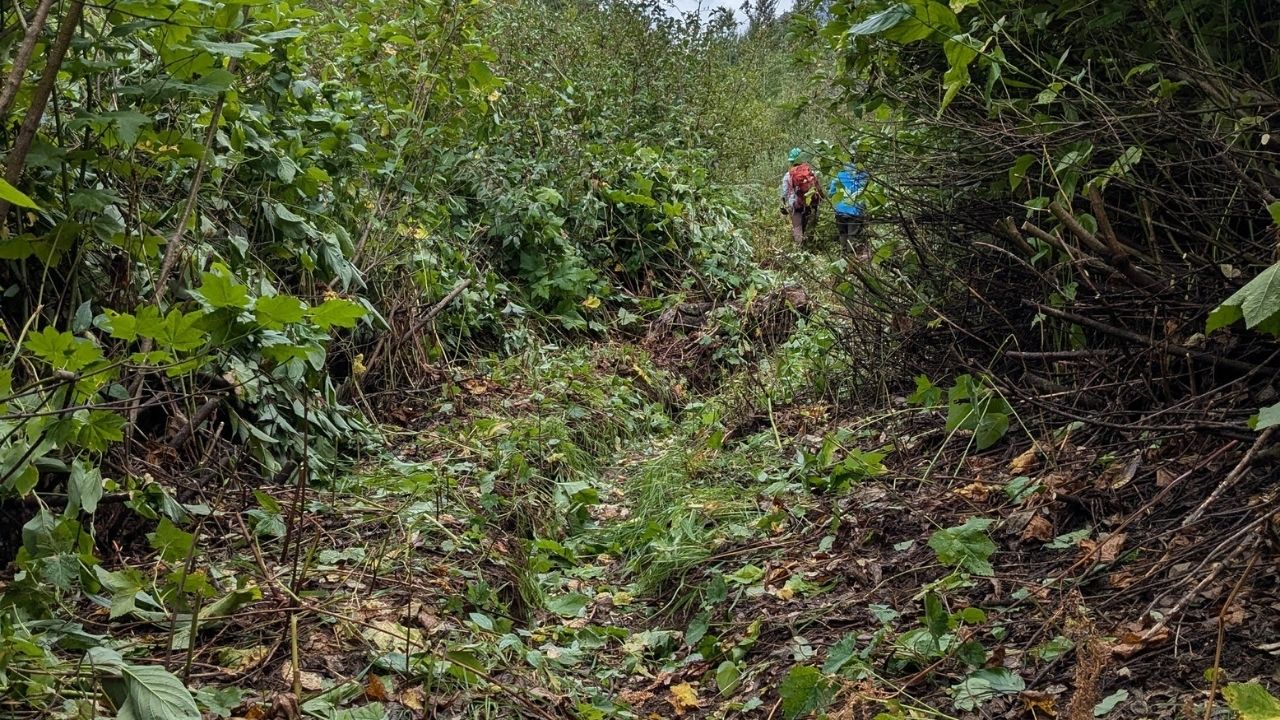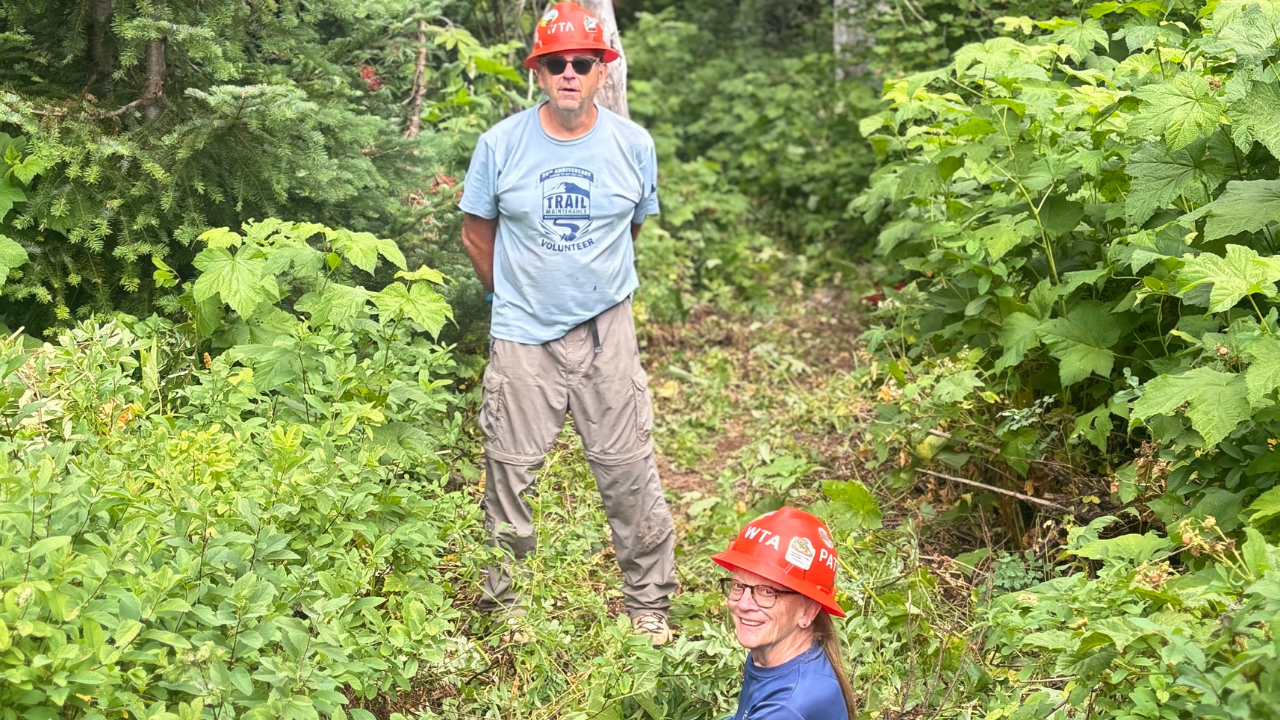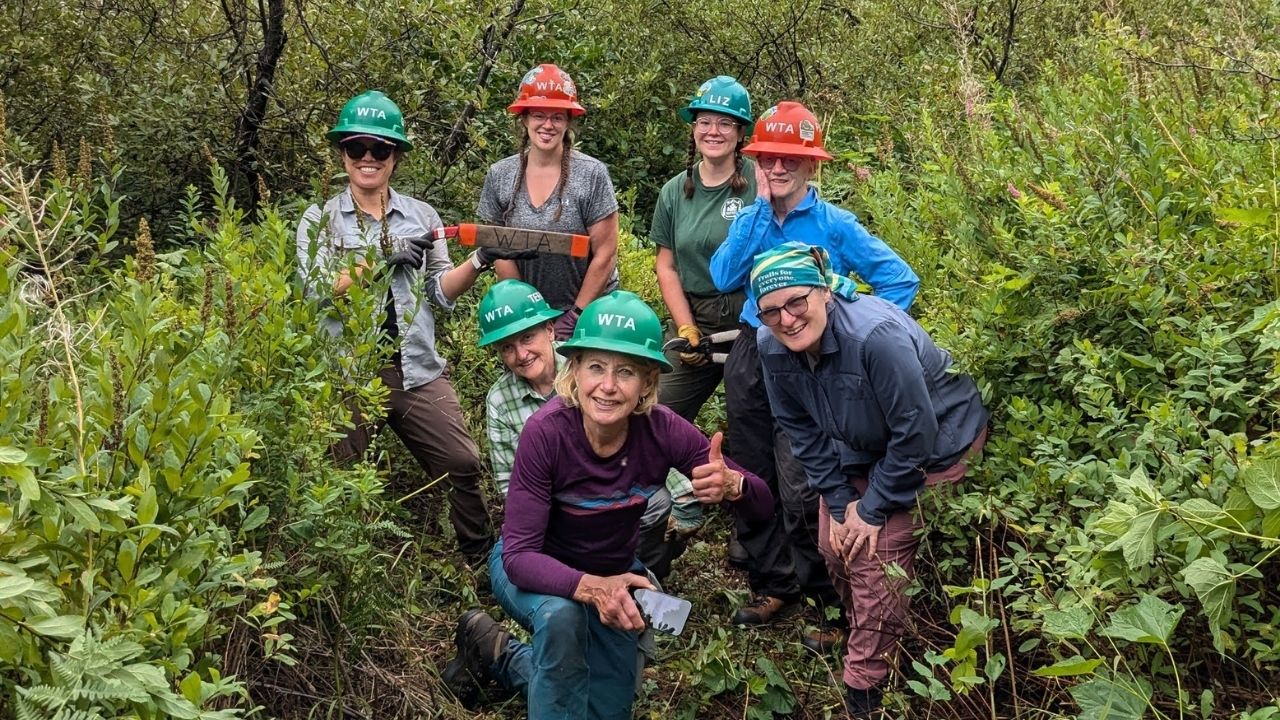The deeply rewarding work of clearing a trail lost to time and brush
WTA crews have been working to restore the White River trail, which would open up loop options and smoother access to the PCT in the Glacier Peak Wilderness.
By Erin McMillin
If you’ve ever spent an afternoon wrestling through overgrown brush on a trail or in your garden, you know that it can be a frustrating experience — especially when it’s wet. Now, picture spending 5 days cutting through an endless valley of brush taller than you through clouds of mosquitoes. That’s exactly what WTA crews did on the White River Trail in 2024 and 2025 but they all came back smiling. Why do they keep coming back for more? Because there is something deeply rewarding about recovering a trail that’s been lost to time.

Brushing in progess! Photo by Lisa Black.
“In the almost 30 years I have been doing volunteer trail work, I have to say working on the White River Trail has been one of the most satisfying I have ever been a part of recovering,” said volunteer Pat Limberg. “I have worked on many trails lost to yearly vegetation growth but nothing like this one. The progress is slow but the results are amazing. I only hope it will continue to be a trail given much needed attention going forward. It is a real gem.”

Pat enjoying a day of hard work on the White River Trail before crews finished their impressive work. Photo by Elizabeth Storm.
The White River trailhead is a 30 minute drive from Lake Wenatchee. On summer weekends, the trail register is full of hikers heading out for shady day hikes or leg-burning climbs up Mount David, Indian Creek and Boulder Creek. WTA crews ran into many different kinds of people using the trail including: Boy Scout troops, hunters, horse-riders, families, solo-hikers and even a group of pack goats!
The trail begins as a mostly flat path meandering through old growth forests. Most hikers turn around at the 4 mile point or climb up the Boulder Creek trail for overnight alpine adventures. Some brave adventurers continue on the White River trail that goes another 10 miles, gradually climbing 3,000 feet to reach the Pacific Crest Trail (PCT), but they are quickly caught in a mess of overgrown brush and downed logs that completely obscure the trail.

Two volunteers smile in anticpation ahead of clearing brush from the beautiful trail ahead. Photo by Lisa Black.
While the first 4 miles of the White River Trail are in decent shape, the 10 miles past Boulder Creek junction to the PCT hasn’t been maintained in over a decade. The last known maintenance was in July 2012 when a WTA volunteer vacation crew spent a week cutting back brush. Even in 2012, the trail wasn’t getting regular maintenance. The Wenatchee River District of the Forest Service maintains over 800 miles of trail. With dwindling funding for Forest Service staff, they didn’t have capacity to maintain this trail regularly. When trails go unmaintained for too long, it requires even more work to bring them back.
In 2024, a brave all-womens trip was the first trail maintenance crew to tackle the White River trail in over a decade. The crew of 8 volunteers cleared a mile of trail, often cutting brush that was twice their height during an unseasonably rainy week in July. Long-time volunteer crew leader Lisa Black was so impressed by the progress that she insisted on bringing another crew back in 2025. They cleared another three-quarters of a mile. The 2025 crew was supported by Forest Service pack mules who carried their food and camp gear to the campsite and they got a surprise visit from the beloved “Pie Guy.”

Hard working trail crews enjoying treats delievered by everyone's favorite Pie Guy! Photo by Lisa Black.
Cutting overgrown brush is not the most glamorous task in trailwork, but it is critical to keep a trail on the map. Woody shrubs like willows, thimbleberry and spirea grow fast and can easily take over a trail corridor. As wildfires become more common, they leave behind sunny expanses where brush grows even faster.
Cutting back brush doesn’t just make a trail more passable, it also protects the structure of the trail. On steep slopes, crews take extra care to cut brush on the uphill side to encourage hikers to avoid walking on the fragile downhill slope. The best maintenance practice is to cut brush every 5 years and leave a wide 8-foot corridor to account for quick brush growth. With limited resources, this 5-year maintenance schedule is rarely achieved.
Two WTA backcountry crews cleared heavy brush on the White River trail, starting to open up this alternative route to the Pacific Crest Trail. Map by Erin McMillin
Trails that connect the PCT to roads are called feeder trails. Feeder trails provide opportunities for thru-hikers and section-hikers to leave the trail to resupply food. They are also critical emergency access points for search and rescue and firefighting crews. If the PCT is a highway, these feeder trails are entrance and exit ramps. It’s critical to have plenty of exit ramps to avoid traffic jams, clear accidents and keep trails in good condition.
“In 2024 two PCT hikers thanked us for the little work we’d done, said Elizabeth Storm, who volunteered on the White River Trail. “It took them all day to go 5 miles due to how overgrown and the amount of trees down. Those hikers that see first hand the work we’re doing are the reason I love this type of trip.”

Our trail crews have a lot to smile about after a hard days work on White River Trail. Photo by Lisa Black.
The White River trail is just one of many wilderness trails in Washington state that have become lost without maintenance. As a result of several decades of funding cuts, the Forest Service has been struggling to keep up with the overwhelming maintenance backlog. With limited staff, they have to make strategic decisions about which trails get priority, and many trails are lost to time. For decades, WTA has partnered with the Forest Service to help fill this maintenance gap, but there is still a lot of work to do. Recent cuts to funding and staffing only make this work more challenging.
You can join WTA in advocating for Forest Service positions. Join our Trail Action Network and we’ll let you know when your voice is needed.
If you want to join WTA crews in the satisfying work of recovering the White River trail or others like it, consider signing up for a volunteer trail crew.


Comments